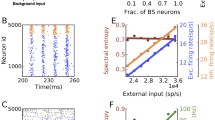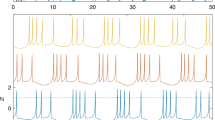Abstract
This numerical study documents and analyzes emergent spiking behavior in local neuronal populations. Emphasis is given to a phenomenon we call clustering, by which we refer to a tendency of random groups of neurons large and small to spontaneously coordinate their spiking activity in some fashion. Using a sparsely connected network of integrate-and-fire neurons, we demonstrate that spike clustering occurs ubiquitously in both high firing and low firing regimes. As a practical tool for quantifying such spike patterns, we propose a simple scheme with two parameters, one setting the temporal scale and the other the amount of deviation from the mean to be regarded as significant. Viewing population activity as a sequence of events, meaning relatively brief durations of elevated spiking, separated by inter-event times, we observe that background activity tends to give rise to extremely broad distributions of event sizes and inter-event times, while driving a system imposes a certain regularity on its inter-event times, producing a rhythm consistent with broad-band gamma oscillations. We note also that event sizes and inter-event times decorrelate very quickly. Dynamical analyses supported by numerical evidence are offered.










Similar content being viewed by others
Notes
1 If the refractory period is absent or too short, g E may increase with each population spike. Our 4ms refractory period was chosen to quench this build-up in conductance and subsequent runaway spiking. It has virtually no effect on regimes other than those with very small α.
References
Battaglia, D., & Hansel, D. (2011). Synchronous chaos and broad band gamma rhythm in a minimal multi-layer model of primary visual cortex. PLoS Computational Biology, 7 (10), e1002176.
Beggs, J.M., & Plenz, D. (2003). Neuronal avalanches in neocortical circuits. Journal of Neuroscience, 23, 11167–11177.
Börgers, C., & Kopell, N. (2003). Synchronization in networks of excitatory and inhibitory neurons with sparse, random connectivity. Neural Computation, 15 (3), 509539.
Börgers, C., & Kopell, N. (2005). Effects of noisy drive on rhythms in networks of excitatory and inhibitory neurons. Neural Computation, 17 (3), 557608.
Börgers, C., Epstein, S., Kopell, N. (2005). Background gamma rhythmicity and attention in cortical local circuits: A computational study. Proceedings of the National Academy of the Sciences of the United States of America, 102 (19), 7002–7007.
Brunel, N. (2000). Dynamics of sparsely connected networks of excitatory and inhibitory spiking neurons. Journal of Comparative Neuroscience, 8, 183–208.
Churchland, M.M., & et al. (2010). Stimulus onset quenches neural variability: A widespread cortical phenomenon. Nature Neuroscience, 13 (3), 369–378.
Dehghani, N., Hatsopoulos, N.G., Haga, Z.D., Parker, R.A., Greger, B., Halgren, E., Cash, S.S., Destexhe, A. (2012). Avalanche analysis from multi-electrode ensemble recordings in cat, monkey and human cerebral cortex during wakefulness and sleep. arXiv: http://arxiv.org/abs/1203.0738v4[q-bio.NC].
Deville, L., & Peskin, C.S. (2008). Synchrony and asynchrony in a fully stochastic neural network. Bulletin of Mathematical Biology, 70 (6), 1608–1633.
Hahn, G., Petermann, T., Havenith, M.N., Yu, S., Singer, W., Plenz, D., Nikolic, D. (2010). Neuronal avalanches in spontaneous activity in vivo. Journal of Neurophysiology, 104, 3312–22.
Hansel, D., & Sompolinsky, H. (1996). Chaos and synchrony in a model of a hypercolumn in visual cortex. Journal of Comparative Neuroscience, 3, 7–34.
Hansel, D., Mato, G., Meunier, C. (1993). Clustering and slow switching in globally coupled phase oscillators. Physical Review E, 48 (5).
Henrie, W., & Shapley, R. (2005). LFP power spectra in V1 cortex: the graded effect of stimulus contrast. Journal of Neurophysiology, 94, 479–90.
Kilpatrick, Z.P., & Ermentrout, B. (2011). Sparse gamma rhythms arising through clustering in adapting neuronal networks. PLoS Computational Biology, 7 (11), e1002281 . doi:10.1371/journal.pcbi.1002281.
Koch, C. (1999). Biophysics of computation. London: Oxford University Press.
Kriener, B., Tetzlaff, T., Aertsen, A., Diesmann, M., Rotter, S. (2008). Correlations and population dynamics in cortical networks. Neural Computation, 20, 2185–2226.
Kuramoto, Y. (1975) In Arakai, H. (Ed.), International symposium on mathematical problems in theoretical physics, Lecture notes in physics (Vol. 39, p. 420). New York: Springer.
Leinekugel, X., Khazipov, R., Cannon, R., Hirase, H., Ben-Ari, Y., Buzsaki, G. (2002). Correlated bursts of activity in the neonatal hippocampus in vivo. Science, 296 (5575), 2049– 2052.
Litwin-Kumar, A., & Doiron, B. (2012). Slow dynamics and high variability in balanced cortical networks with clustered connections. Nature Neuroscience. doi:10.1038/nn.3220.
Luczak, A., Bartho, P., Harris, K.D. (2013). Gating of sensory input by spontaneous cortical activity. Journal of Neuroscience, 33 (4), 1684–1695. doi:10.1523/JNEUROSCI.2928-12.2013.
Mark, S., & Tsodyks, M. (2012). Population spikes in cortical networks during different functional states. Frontiers in Computational Neuroscience, 6, 43. doi:10.3389/fncom.
Mazzoni, A., & et al. (2007). On the dynamics of the spontaneous activity in neuronal networks. PLoS One, 5, e539.
Mirollo, R.E., & Strogatz, S.H. (1990). Synchronization of pulse-coupled biological oscillators . SIAM Journal on Applied Mathematics, 50 (6), 1645–1662.
Okun, M., Yger, P., Marguet, S.L., Gerard-Mercier, F., Benucci, A., Katzner, S., et al. (2012). Population rate dynamics and multineuron firing patterns in sensory cortex. Journal of Neuroscience, 32 (48), 17108–17119. doi:10.1523/JNEUROSCI.1831-12.2012.
Plenz, D., & et al. (2011). Multi-electrode array recordings of neuronal avalanches in organotypic cultures. Journal of Visualized Experiments, 1:pii, 2949.
Rangan, A.V., & Young, L.S. (2013a). Emergent dynamics in a model of visual cortex. Journal of Computational Neuroscience, 35 (2), 155–167.
Rangan, A.V., & Young, L.S. (2013b). Dynamics of spiking neurons: Between homogeneity and synchrony. Journal of Computational Neuroscience, 34 (3), 433–460.
Samonds, J.M, Zhou, Z., Bernard, M.R., Bonds, A.B. (2005). Synchronous activity in cat visual cortex encodes collinear and cocircular contours. Journal of Neurophysiology, 95 (4), 2602–2616.
Shew, W.L., & et al. (2011). Information capacity and transmission are maximized in balanced cortical networks with neuronal avalanches. Journal Neuroscience, 31, 55–63.
Staude, B., Rotter, S., Grün, S. (2009). CuBIC: cumulant based inference of higher-order correlations in massively parallel spike trains. Journal of Computational Neuroscience. doi:10.1007/s10827-009-0195-x.
Trousdale, J., Hu, Y., Shea-Brown, E., Josić, K. (2013). Newblock a generative spike train model with time-structured higher order correlations. Frontiers in Computational Neuroscience, 7.
Tsodyks, M., Mitkov, I., Sompolinsky, H. (1993). Pattern of synchrony in inhomogeneous networks of oscillators with pulse interactions. Physical Review Letters, 71 (8), 1280–1283.
Tsodyks, M., Uziel, A., Markram, H. (2000). Synchrony generation in recurrent networks with frequency- dependent synapses. Journal of Neuroscience, 20, RC50.
Whittington, M.A., Traub, R.D., Kopell, N., Ermentrout, B., Buhl, E.H. (2000). Inhibition-based rhythms: experimental and mathematical observations on network dynamics. International Journal of Psychophysiology, 38, 315–336.
Yu, S. et al. (2011). Higher-order interactions characterized in cortical activity. Journal Neuroscience, 31, 17514–17526.
Author information
Authors and Affiliations
Additional information
Action Editor: David Terman
Conflict of interest
The authors declare that they have no conflict of interest
This research is supported in part by NSF Grant DMS-1101594.
Rights and permissions
About this article
Cite this article
Chariker, L., Young, LS. Emergent spike patterns in neuronal populations. J Comput Neurosci 38, 203–220 (2015). https://doi.org/10.1007/s10827-014-0534-4
Received:
Revised:
Accepted:
Published:
Issue Date:
DOI: https://doi.org/10.1007/s10827-014-0534-4




